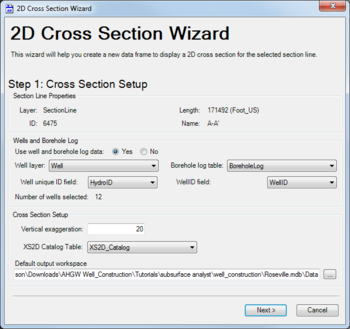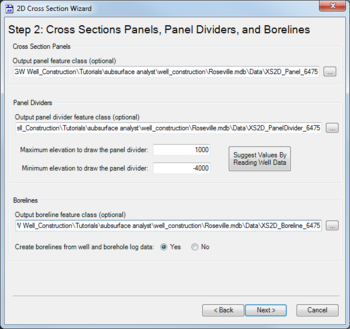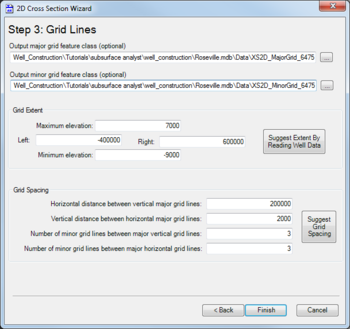AHGW:2D Cross Section Wizard
From XMS Wiki
Jump to navigationJump to search
The 2D XS2D Cross Section pane is accessed by clicking ![]() Create 2D Cross Section on the Arc Hydro Groundwater Ribbon. This tool helps register a digital cross section image for use in building 2D cross sections in ArcGIS Pro.
Create 2D Cross Section on the Arc Hydro Groundwater Ribbon. This tool helps register a digital cross section image for use in building 2D cross sections in ArcGIS Pro.
The following sections, options, and fields are available:
SectionLine, Well and Borehold Logs, and Cross Section Setup
- SectionLine section – Contains tools for selecting the desired SectionLine. Also, lists attributes of the selected SectionLine.
- SectionLine Layer – Select the desired SectionLine layer from the drop-down.
 – Select this icon to activate the select tool. Then, left-click on the SectionLine feature that will be used to create the XS2D cross section. Once the SectionLine is selected, its attributes will appear in the ID, Length, and Name fields.
– Select this icon to activate the select tool. Then, left-click on the SectionLine feature that will be used to create the XS2D cross section. Once the SectionLine is selected, its attributes will appear in the ID, Length, and Name fields.
- Wells and Borehole Logs section – Contains options for selecting wells and borehole logs.
- Use well and borehole log data – Select Yes or No. Selecting "no" allows the user to proceed without selecting any wells.
- Well layer – Select the desired layer from the drop-down.
- Well unique ID field – Select the field to use as the well unique ID field. Default value is "HydroID".
- Borehole log table – Select the desired table from the drop-down.
- WellID field – Select the field to use as the WellID field. Default value is WellID.
- Cross Section Setup section – Contains options for the setup of the cross section.
- Vertical exaggeration – Enter a decimal value for the amount of vertical exaggeration in the display of the information.
- XS2D Catalog Table – Select the table from the drop-down.
Panel Dividers, Grid settings, and Running the Tool
- Panel Divider Elevations section
- Minimum – A decimal value for the minimum elevation at which to draw the panel divider.
- Maximum – A decimal value for the maximum elevation at which to draw the panel divider.
- Suggest Elevations – Click to populate the above two fields with suggested values based on the image registration being used.
- Grid Extent section
- Top – Enter a decimal value for the maximum elevation.
- Bottom – Enter a decimal value for the minimum elevation.
- Left – Enter a decimal value for the left extent.
- Right – Enter a decimal value for the right extent.
- Suggest Grid Extent – Click to populate the above four fields with suggested values based on the image registration being used.
- Grid Spacing section
- Distance between major grid lines
- Horizontal – A decimal value for the horizontal distance between vertical major grid lines.
- Vertical – A decimal value for the vertical distance between horizontal major grid lines.
- Number of minor grid lines
- Vertical – Integer value for number of minor grid lines between major vertical grid lines.
- Horizontal – Integer value for number of minor grid lines between major horizontal grid lines.
- Suggest Grid Spacing – Click to populate the above four fields with suggested grid spacing values.
- Distance between major grid lines
- Create XS2D Data – Runs the Create XS2D Cross Section tool. The tool uses the information entered to create an XS2D data frame and a map view representing the features entered. Once the XS2D data frame has been created, ArcGIS Pro drawing tools can be used to digitize a cross section.
ArcGIS Notes
The 2D Cross Section Wizard dialog is accessed by clicking ![]() 2D Cross Section Wizard on the Arc Hydro Groundwater Toolbar. This tool helps create a new data frame in which to display a 2D cross section for the selected section line in ArcGIS.
2D Cross Section Wizard on the Arc Hydro Groundwater Toolbar. This tool helps create a new data frame in which to display a 2D cross section for the selected section line in ArcGIS.
There are three pages to this dialog:
- Step 1: Cross Section Setup
- Step 2: Cross Sections Panels, Panel Dividers, and Borelines
- Step 3: Grid Lines
Cross Section Setup
The following sections, options, and fields are available:
- Section Line Properties section – Not user editable. Lists attributes of the selected section line.
- Wells and Borehole Log section
- Use well and borehole log data – Select Yes or No. Selecting "no" allows the user to proceed without selecting any wells.
- Well layer – Select the desired layer from the drop-down.
- Well unique ID field – Select the field to use as the well unique ID field. Default value is "HydroID".
- Borehole log table – Select the desired table from the drop-down.
- WellID field – Select the field to use as the WellID field. Default value is WellID.
- Number of wells selected – Displays the quantity of wells selected. If no wells are selected, may display a warning to the right of the quantity value.
- Cross Section Setup section
- Vertical exaggeration – Enter a decimal value for the amount of vertical exaggeration in the display of the information.
- XS2D Catalog Table – Select the table from the drop-down.
- Default output workspace – Displays the absolute path to the output workspace. Click
 to bring up the Select Output Workspace dialog where a new output workspace can be created.
to bring up the Select Output Workspace dialog where a new output workspace can be created.
- Next – Switches to the second page of the 2D Cross Section Wizard dialog.
- Cancel – Cancels any changes and exits the 2D Cross Section Wizard dialog.
Cross Sections Panels, Panel Dividers, and Borelines
The following sections, options, and fields are available:
- Cross Section Panels section – An optional path for Output panel feature class. Click
 to bring up the Save Panel Features As dialog where a new feature class can be entered and saved. A default value will already be populated.
to bring up the Save Panel Features As dialog where a new feature class can be entered and saved. A default value will already be populated. - Panel Dividers section – An optional path for Output panel divider feature class. Click
 to bring up the Save Panel Divider Features As dialog where a new feature class can be entered and saved. A default value will already be populated.
to bring up the Save Panel Divider Features As dialog where a new feature class can be entered and saved. A default value will already be populated.
- Maximum elevation to draw the panel divider – Enter a decimal maximum elevation value.
- Minimum elevation to draw the panel divider – Enter a positive or negative decimal minimum elevation value.
- Suggest Values by Reading Well Data – Click to populate the above two fields with suggested values based on the well data being used.
- Borelines section – An optional path for Output boreline feature class. Click
 to bring up the Save Boreline Features As dialog where a new feature class can be entered and saved. A default value will already be populated.
to bring up the Save Boreline Features As dialog where a new feature class can be entered and saved. A default value will already be populated.
- Create borelines from well and borehole log data – Select Yes or No.
- Back – Switches back to the first page of the 2D Cross Section Wizard dialog.
- Next – Switches to the third page of the 2D Cross Section Wizard dialog.
- Cancel – Cancels any changes and exits the 2D Cross Section Wizard dialog.
Grid Lines
The following sections, options, and fields are available:
- Output major grid feature class – An optional path. Click
 to bring up the Save Major Grid Features As dialog where a new feature class can be entered and saved. A default value will already be populated.
to bring up the Save Major Grid Features As dialog where a new feature class can be entered and saved. A default value will already be populated. - Output minor grid feature class – An optional path. Click
 to bring up the Save Minor Grid Features As dialog where a new feature class can be entered and saved. A default value will already be populated.
to bring up the Save Minor Grid Features As dialog where a new feature class can be entered and saved. A default value will already be populated. - Grid Extent section – Contains four fields, listed clockwise from the top, and a button:
- Maximum elevation – A decimal value for the maximum elevation of the grid.
- Right – A decimal value for the right extent of the grid.
- Minimum elevation – A decimal value for the minimum elevation of the grid.
- Left – A decimal value for the left extent of the grid.
- Suggest Extent by Reading Well Data – Click to populate the above four fields with suggested values based on the well data being used.
- Grid Spacing section
- Horizontal distance between vertical major grid lines – Decimal value.
- Vertical distance between horizontal major grid lines – Decimal value.
- Number of minor grid lines between major vertical grid lines – Integer value.
- Number of minor grid lines between major horizontal grid lines – Integer value.
- Suggest Grid Spacing – Click to populate the above four fields with suggested values based on the grid dimensions.
- Back – Switches back to the second page of the 2D Cross Section Wizard dialog.
- Finish – Saves the values and closes the 2D Cross Section Wizard dialog.
- Cancel – Cancels any changes and exits the 2D Cross Section Wizard dialog.




